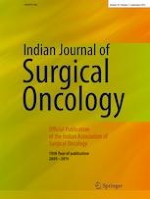Erschienen in:

21.06.2019 | Original Article
Serratus Anterior Plane Block for Post-Thoracotomy Analgesia: a Novel Technique for the Surgeon and Anaesthetist
verfasst von:
Saurabh Vig, Swati Bhan, Deepti Ahuja, Nishkarsh Gupta, Vinod Kumar, Sunil Kumar, Sachidanad Jee Bharati
Erschienen in:
Indian Journal of Surgical Oncology
|
Ausgabe 3/2019
Einloggen, um Zugang zu erhalten
Abstract
Post-thoracotomy pain is one of the most severe forms of post-operative pain. Anaesthetists usually manage post-thoracotomy pain with an epidural or paravertebral block. However, both of these techniques have their limitations. Ultrasound-guided interfascial plane block like serratus anterior plane block is a new concept and is proposed to provide analgesia to the hemithorax. We report our experience with 10 thoracotomy cases where this block was used as a post-operative analgesic technique. Patients undergoing pulmonary metastasectomy or lobectomy received ultrasound-guided serratus anterior plane block between the serratus anterior and the external intercostal muscles with 0.25% ropivacaine, and a catheter was inserted. Post-operatively, 0.125% ropivacaine with fentanyl (1 mcg/ml) was given as infusion at 5–7 ml/h. Other analgesics were paracetamol and diclofenac. Fentanyl infusion at 0.25 mcg/kg/h was the rescue analgesic if pain persisted. Four out of 10 patients required fentanyl infusion. Uncontrolled pain in two of these patients was at the intercostal drain site; in the third patient, two ribs were resected; and in the 4th patient, there was poor drug spread and the catheter could not be placed in the desired plane due to poor muscle mass. The catheter was kept in situ for a minimum of 48 h to a maximum of 6 days after surgery. Serratus anterior block could be an attractive option for post-thoracotomy analgesia. Further studies can take the help of the surgeon for catheter placement in the desired plane at the time of wound closure to ensure adequate drug spread.